Hand, Nail, and Skin Analysis: A Comprehensive Guide for Beauticians
For a beautician, the well-being of the client is of paramount importance. An essential preliminary step before embarking on any nail service is a meticulous analysis of the client’s hands, nails, and skin. This not only ensures safety and quality but also helps in customizing treatments to cater to individual needs.

Hand, Nail, and Skin Analysis
The Significance of Analysis
1. Identification of Health Concerns: An in-depth analysis aids in spotting diseases, infections, or conditions that might require medical intervention or caution during the nail service.
2. Customization: Through a thorough understanding of a client’s skin, nails, and overall hand health, treatments can be tailored to cater specifically to individual requirements, ensuring optimal results.
Step-by-Step Guide to Hand, Nail, and Skin Analysis
1. Cleanliness is Key
Start by cleaning both your hands and the client’s. This not only ensures a safe environment but also helps in getting a clearer view of the nails and skin.
2. Observe and Feel
Using sight and touch, evaluate:
- Skin Moisture: Healthy skin is soft and supple. Look out for signs of dehydration or flakiness which indicate a lack of moisture.
- Skin Temperature: Cold skin could denote poor circulation, while warm skin could be a sign of infection.
- Skin Condition: Any redness or other discoloration could be indicative of inflammation or infection. The skin should ideally be disease-free.
- Tenderness: While feeling the client’s hands, ascertain if there’s any pain. If the client experiences discomfort, this might necessitate extra caution during procedures like massages.
- Nail Assessment: Examine the nails meticulously, including their shape, length, thickness, and overall health. Your knowledge will be instrumental in distinguishing between healthy nails and those requiring a physician’s attention.
3. Engage the Client
It’s imperative to get detailed feedback from your client. Some probing questions to consider include:
- Lifestyle Habits: Inquire about any habits that might adversely impact the nails, like gardening. Also, ask how they safeguard their nails and skin from such hazards.
- Recent Changes: Ascertain if they’ve observed any alterations in their skin or nail health recently, such as chafing or dryness.
- Medication and Health: Questions about medication are essential since some medicines can influence the nail service. For instance, diabetic clients should not undergo treatments with nail nippers.
- Weather Impact: Determine if seasonal changes affect their skin health.
- Home Care: Get insights into their at-home nail care regimen.
- Products Used: Understand the types of lotions or oils they apply, such as hemp, aloe, or cannabis.
4. Conclude with Feedback
Post-examination, it’s crucial to share your observations with the client:
- Point out any instances of onychosis (nail diseases, disorders, or conditions).
- Discuss potential causes, whether they’re systemic, environmental, etc.
- Recommend appropriate services or, if necessary, refer them to a medical professional.
- Finally, propose a home maintenance plan and discuss future service strategies.
Conclusion
A thorough hand, nail, and skin analysis isn’t merely a procedural step. It forms the foundation of the client-beautician relationship, ensuring safety, trust, and optimum service delivery. As beauty professionals, ensuring a client’s health while delivering top-notch service is the hallmark of expertise and dedication.






